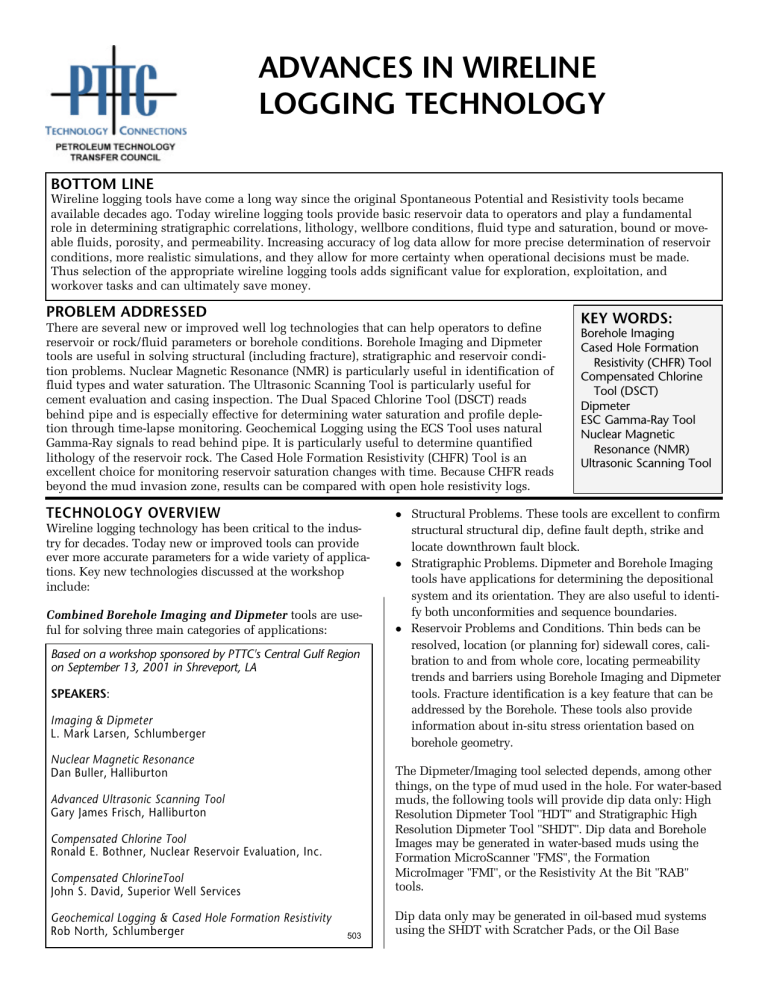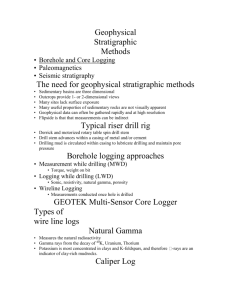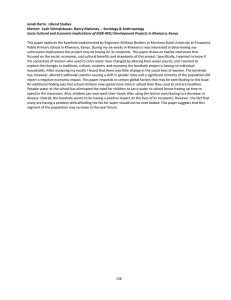
ADVANCES IN WIRELINE LOGGING TECHNOLOGY BOTTOM LINE Wireline logging tools have come a long way since the original Spontaneous Potential and Resistivity tools became available decades ago. Today wireline logging tools provide basic reservoir data to operators and play a fundamental role in determining stratigraphic correlations, lithology, wellbore conditions, fluid type and saturation, bound or moveable fluids, porosity, and permeability. Increasing accuracy of log data allow for more precise determination of reservoir conditions, more realistic simulations, and they allow for more certainty when operational decisions must be made. Thus selection of the appropriate wireline logging tools adds significant value for exploration, exploitation, and workover tasks and can ultimately save money. PROBLEM ADDRESSED There are several new or improved well log technologies that can help operators to define reservoir or rock/fluid parameters or borehole conditions. Borehole Imaging and Dipmeter tools are useful in solving structural (including fracture), stratigraphic and reservoir condition problems. Nuclear Magnetic Resonance (NMR) is particularly useful in identification of fluid types and water saturation. The Ultrasonic Scanning Tool is particularly useful for cement evaluation and casing inspection. The Dual Spaced Chlorine Tool (DSCT) reads behind pipe and is especially effective for determining water saturation and profile depletion through time-lapse monitoring. Geochemical Logging using the ECS Tool uses natural Gamma-Ray signals to read behind pipe. It is particularly useful to determine quantified lithology of the reservoir rock. The Cased Hole Formation Resistivity (CHFR) Tool is an excellent choice for monitoring reservoir saturation changes with time. Because CHFR reads beyond the mud invasion zone, results can be compared with open hole resistivity logs. TECHNOLOGY OVERVIEW l Wireline logging technology has been critical to the industry for decades. Today new or improved tools can provide ever more accurate parameters for a wide variety of applications. Key new technologies discussed at the workshop include: Combined Borehole Imaging and Dipmeter tools are useful for solving three main categories of applications: Based on a workshop sponsored by PTTC's Central Gulf Region on September 13, 2001 in Shreveport, LA SPEAKERS: Imaging & Dipmeter L. Mark Larsen, Schlumberger Nuclear Magnetic Resonance Dan Buller, Halliburton l l KEY WORDS: Borehole Imaging Cased Hole Formation Resistivity (CHFR) Tool Compensated Chlorine Tool (DSCT) Dipmeter ESC Gamma-Ray Tool Nuclear Magnetic Resonance (NMR) Ultrasonic Scanning Tool Structural Problems. These tools are excellent to confirm structural structural dip, define fault depth, strike and locate downthrown fault block. Stratigraphic Problems. Dipmeter and Borehole Imaging tools have applications for determining the depositional system and its orientation. They are also useful to identify both unconformities and sequence boundaries. Reservoir Problems and Conditions. Thin beds can be resolved, location (or planning for) sidewall cores, calibration to and from whole core, locating permeability trends and barriers using Borehole Imaging and Dipmeter tools. Fracture identification is a key feature that can be addressed by the Borehole. These tools also provide information about in-situ stress orientation based on borehole geometry. Compensated ChlorineTool John S. David, Superior Well Services The Dipmeter/Imaging tool selected depends, among other things, on the type of mud used in the hole. For water-based muds, the following tools will provide dip data only: High Resolution Dipmeter Tool "HDT" and Stratigraphic High Resolution Dipmeter Tool "SHDT". Dip data and Borehole Images may be generated in water-based muds using the Formation MicroScanner "FMS", the Formation MicroImager "FMI", or the Resistivity At the Bit "RAB" tools. Geochemical Logging & Cased Hole Formation Resistivity Rob North, Schlumberger Dip data only may be generated in oil-based mud systems using the SHDT with Scratcher Pads, or the Oil Base Advanced Ultrasonic Scanning Tool Gary James Frisch, Halliburton Compensated Chlorine Tool Ronald E. Bothner, Nuclear Reservoir Evaluation, Inc. 503 Dipmeter Tool "OBDT". Dip and borehole image data are collected using the Ultrasonic Borehole Imager "UBI", the FMI, or the OBMI Oil Base Mud Imager. Minimum and maximum borehole size limitations for the various Formation MicroImager logs are as follows: Ultrasonic Borehole Imager (UBI) 5.5"-12.875, Formation Microscanner FMS-B, 4.5"-15", FMS-C 6.25"-21", and the Formation MicroImager (FMI) is 6.25"-21". Each of these tools has a maximum temperature range of 350° F. Nuclear Magnetic Resonance (NMR) is a new borehole measurement technique that allows a continuous log of parameters such as permeability, volume of moveable fluids and lithology-independent porosity. It is particularly useful for determining fluid types; rock data is not recorded with the NMR technology. NMR logging trials have shown that three quantities are measured with this new tool: l l l Lithology-independent porosity: Because only oil and water contain abundant hydrogen, the magnitude of the NMR signal responds only to the liquid-filled porosity. Permeability: The decay rate of the NMR signal is related to the permeability of sandstones. NMR-derived permeability is typically an order of magnitude more accurate than permeability derived from a porosity-permeability relationship. Initial water saturation: By comparing the fast relaxing fraction of the NMR signal with the slow relaxing fraction, the amount of movable fluid in the pore space can be determined. This is known as the Free Fluid Index (FFI) of the formation and is an estimate of the initial water saturation. Values for these parameters can be determined accurately for sandstone and do not need calibration of rock parameters (i.e., core is not needed). Such calibration, however, is still required for carbonate rocks. Some applications for the NMR tool include effective porosity (including vuggy vs. matrix porosity), permeability, pore size distribution, producible fluids, predicted water cut, oil viscosity, and wettability. It should be recognized that NMR has nothing to do with radioactivity and the logging tool does not contain any nuclear sources. NMR refers to the physical principal of resonance of nuclei in a magnetic field. The Ultrasonic Scanning Tool has two main uses: cement evaluation and for casing inspection. For cement evaluation, it is recommended that one use a cement interpretation logging tool combination that includes a Cement Bond Log (CBL) and a single or multitransducer Ultrasonic tool. This combination of tools should prove effective for evaluating conventional cement slurries and foam and complex cement slurries. Cement evaluation is strongly recommended for wells with multiple pays. It will help determine zonal isolation and can there- fore reduce unnecessary remedial work. This can lead to operational cost savings. Casing inspection using the Ultrasonic Scanning Tool requires corrections for borehole eccentricity. The image mode of this tool provides accurate internal wear assessment (up to 60 samples/ft) while the cased-hole mode (up to 12 samples/ft) provides accurate casing thickness data. The Dual Spaced Chlorine Tool (DSCT) reads behind pipe. This tool is effective for determining current water saturation, gas/oil/water contacts, distinguishing between high porosity gas zones and low permeability (tight) intervals, profile depletion through time-lapse monitoring, and identifying formation water resistivity changes with respect to well depth. An important feature of this tool is that it may be used in shaley sands. This tool is battery powered, has a maximum outside diameter of 1 11/16 inches over a 16 ft length, weighs 60 lbs and is rated to 450° F and 22,000 psi. It is rated at 5 samples/ft and 20 ft/min with a vertical resolution of 8 inches. The recommended logging speed is, however, a function of formation porosity, salinity, and wellbore geometry. Recommended conditions for optimal DSCT performance include porosity greater than 15% and salinity greater than 25,000 ppm Cl. Well bore configuration recommendations for high performance include boreholes of 12 ¼ inches or less, casing sizes of 9 5/8 inches or less, absence of concentric casing strings, and a preference for liquid-filled annulus. GEOCHEMICAL LOGGING AND CASED HOLE RESISTIVITY TOOL The ECS Geochemical Logging tool is the latest in a line of Gamma-Ray measuring tools. It essentially captures from behind pipe a Gamma-Ray Spectrum that is processed to successively determine dry weight elements in the formation (rock) and ultimately dry weight lithologies (e.g., quantified clay, carbonate, anhydrite, etc). The tool is rated at a logging speed of 1,800 ft/hr with a vertical resolution of 1.5 ft. It works in all borehole fluids. The tool has an outside diameter of 5.0 inches over a 6.6 ft length. It is rated to 350° F and 20,000 psi. It will operate in a minimum hole size of 6.0 inches. The ECS and SpectroLith tool provide data to simplify log interpretation and to allow more accurate petrophysical interpretation, real time wellsite decisions such as drilling and completion fluid compatability. Additional applications for these tools include lithology determination for mechanical properties and frac design, enhanced seismic attribute analysis, improved lithological models for reservoir simulation, and chemostratigraphy for improved correlation. The Cased Hole Formation Resistivity (CHFR) Tool provides accurate resistivity measurements through casing. The results have good repeatability in varied production environments. Therefore the tool provides an excellent basis for monitoring reservoir saturation changes with time. CHFR reads beyond mud invasion which effects nuclear tech- niques. It thus allows direct comparison with open-hole resistivity logs. Major applications for this tool include primary resistivity evaluation, locating bypassed pay, and monitoring reservoir saturation changes. CHFR specification includes a tool that is 3 3/8 inches in diameter over a 43 ft length. It is rated to 300° F and 15,000 psi and can operate at a logging speed of 400 ft/hr. The tool requires a casing outside diameter range of 4.5 to 9 5/8 inches. It can operate at any well deviation angle with stand-offs, but only to 70° for 3 3/8 pipe. Vertical resolution is 4 ft and depth of investigation into the formation is 7 to 32 ft CONNECTIONS: L. Mark Larsen Schlumberger 330 Marshall St., Ste. 610 Shreveport, Louisiana 71101 Phone: (318) 222-0474 Fax: (318) 222-0810 Email: larsenm1@slb.com Ronald E. Bothner Nuclear Reservoir Evaluation, Inc. 2608 Southwest Drive New Iberia, LA 70560 Phone: (337)364-3416 Fax: (337)367-5903 Email: ronnie@nregroup.com John S. David Superior Well Services 1207 Redwood Bough Lane Houston, TX 77062 Phone: 1 (888) 485-5429 Fax: (281) 999-6505 Email: johnd37@swbell.net Rob North Schlumberger, DSC-ID 1325 S. Dairy Ashford Rd., Ste. 300 Houston, TX 77077 Phone: (281) 285-1912 Fax: (281) 2851927 Email: robnorth@houston.oilfield.slb.com Dan Buller Halliburton Energy Services 416 Travis St., Ste. 505 Shreveport, Louisiana 711015502 Phone: (318) 673-4415 Fax: (318) 220- 0234 Email: danbuller@halliburton.com Gary James Frisch Halliburton Energy Services 3000 N. Sam Houston Parkway P.O. Box 60078 Houston, TX 77205 Phone: (281) 871-7215 Fax: (281) 871-7211 Email: gary.frisch@halliburton.com For information on PTTC’s Central Gulf Region and its activities contact: Director: Bob Baumann, Managing Director Center for Energy Studies, Louisiana State University One East Fraternity Circle Baton Rouge, Louisiana 70803-0301 Phone: 225-578-4400 Fax: 225-578-4541 Email: rbaumann@lsu.edu Disclaimer: No specific application of products or services is endorsed by PTTC. Reasonable steps are taken to ensure the reliability of sources for information that PTTC disseminates; individuals and institutions are solely responsible for the consequences of its use. The not-for-profit Petroleum Technology Transfer Council is funded primarily by the US Department of Energy’s Office of Fossil Energy, with additional funding from universities, state geological surveys, several state governments, and industry donations. Petroleum Technology Transfer Council, 2916 West T. C. Jester, Suite 103, Houston, TX 77018 toll-free 1-888-THE-PTTC; fax 713-688-0935; e-mail hq@pttc.org; web www.pttc.org


